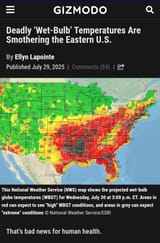You're dead and don't know it
WBGT - Wet Bulb Globe Temperature
The wet bulb danger zone is roughly 30°C (86°F) and above, though a theoretical limit of 35°C (95°F) has been discussed. This higher range is when the body cannot effectively cool itself through sweat, leading to potentially fatal heat stress. Vulnerable populations, such as the elderly and those with chronic illnesses, face danger at lower temperatures, and exposure time is also a critical factor.
Why Wet Bulb Temperature Is So Dangerous
Body Cooling:
The wet bulb temperature measures how much heat the air can hold at 100% humidity. Your body cools itself by sweating, but this only works if sweat can evaporate.
Humidity and Evaporation:
When the wet bulb temperature is high, it means the air is humid and cannot absorb much more moisture. This prevents sweat from evaporating, hindering the body's ability to cool itself.
Increased Body Temperature:
Without effective cooling, your body's core temperature rises, potentially leading to heat exhaustion, heatstroke, and even death.
Danger Levels
Lower End of Danger:
Recent studies suggest a wet bulb temperature of around 87°F (31°C) can be dangerous even for young, healthy people, especially with prolonged exposure or high humidity.
Upper Theoretical Limit:
The theoretical maximum for human survival has been considered to be 95°F (35°C). At this temperature, a person's body would not be able to maintain its core temperature.
The wet bulb danger zone is roughly 30°C (86°F) and above, though a theoretical limit of 35°C (95°F) has been discussed. This higher range is when the body cannot effectively cool itself through sweat, leading to potentially fatal heat stress. Vulnerable populations, such as the elderly and those with chronic illnesses, face danger at lower temperatures, and exposure time is also a critical factor.
Why Wet Bulb Temperature Is So Dangerous
Body Cooling:
The wet bulb temperature measures how much heat the air can hold at 100% humidity. Your body cools itself by sweating, but this only works if sweat can evaporate.
Humidity and Evaporation:
When the wet bulb temperature is high, it means the air is humid and cannot absorb much more moisture. This prevents sweat from evaporating, hindering the body's ability to cool itself.
Increased Body Temperature:
Without effective cooling, your body's core temperature rises, potentially leading to heat exhaustion, heatstroke, and even death.
Danger Levels
Lower End of Danger:
Recent studies suggest a wet bulb temperature of around 87°F (31°C) can be dangerous even for young, healthy people, especially with prolonged exposure or high humidity.
Upper Theoretical Limit:
The theoretical maximum for human survival has been considered to be 95°F (35°C). At this temperature, a person's body would not be able to maintain its core temperature.
